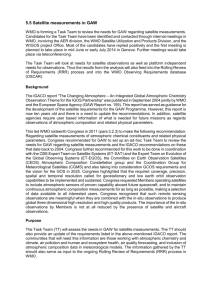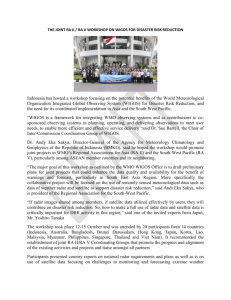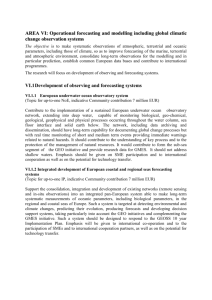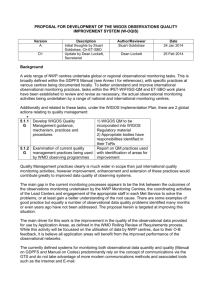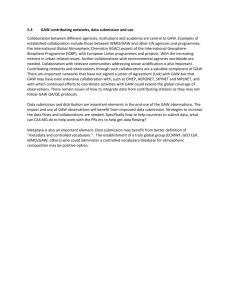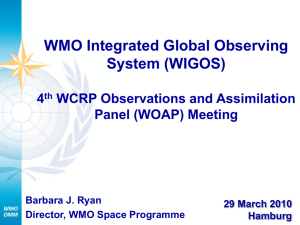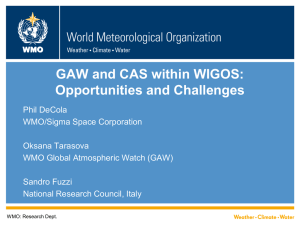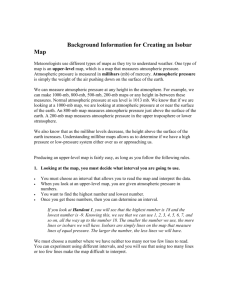Terms of Reference (ToRs)
advertisement
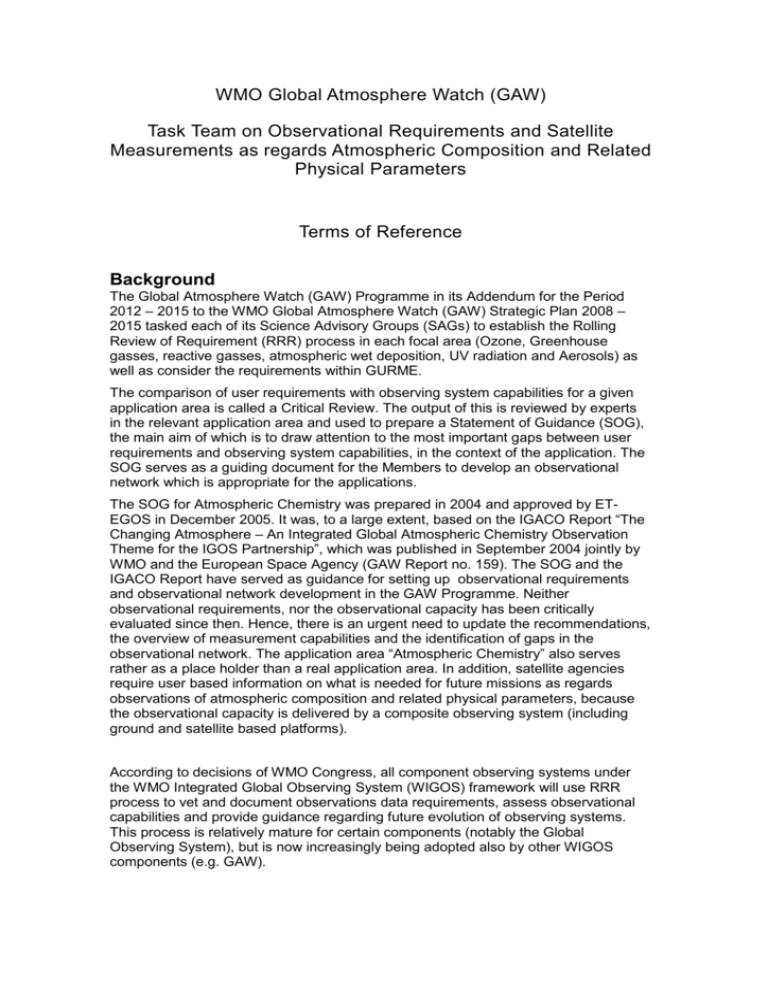
WMO Global Atmosphere Watch (GAW) Task Team on Observational Requirements and Satellite Measurements as regards Atmospheric Composition and Related Physical Parameters Terms of Reference Background The Global Atmosphere Watch (GAW) Programme in its Addendum for the Period 2012 – 2015 to the WMO Global Atmosphere Watch (GAW) Strategic Plan 2008 – 2015 tasked each of its Science Advisory Groups (SAGs) to establish the Rolling Review of Requirement (RRR) process in each focal area (Ozone, Greenhouse gasses, reactive gasses, atmospheric wet deposition, UV radiation and Aerosols) as well as consider the requirements within GURME. The comparison of user requirements with observing system capabilities for a given application area is called a Critical Review. The output of this is reviewed by experts in the relevant application area and used to prepare a Statement of Guidance (SOG), the main aim of which is to draw attention to the most important gaps between user requirements and observing system capabilities, in the context of the application. The SOG serves as a guiding document for the Members to develop an observational network which is appropriate for the applications. The SOG for Atmospheric Chemistry was prepared in 2004 and approved by ETEGOS in December 2005. It was, to a large extent, based on the IGACO Report “The Changing Atmosphere – An Integrated Global Atmospheric Chemistry Observation Theme for the IGOS Partnership”, which was published in September 2004 jointly by WMO and the European Space Agency (GAW Report no. 159). The SOG and the IGACO Report have served as guidance for setting up observational requirements and observational network development in the GAW Programme. Neither observational requirements, nor the observational capacity has been critically evaluated since then. Hence, there is an urgent need to update the recommendations, the overview of measurement capabilities and the identification of gaps in the observational network. The application area “Atmospheric Chemistry” also serves rather as a place holder than a real application area. In addition, satellite agencies require user based information on what is needed for future missions as regards observations of atmospheric composition and related physical parameters, because the observational capacity is delivered by a composite observing system (including ground and satellite based platforms). According to decisions of WMO Congress, all component observing systems under the WMO Integrated Global Observing System (WIGOS) framework will use RRR process to vet and document observations data requirements, assess observational capabilities and provide guidance regarding future evolution of observing systems. This process is relatively mature for certain components (notably the Global Observing System), but is now increasingly being adopted also by other WIGOS components (e.g. GAW). This led WMO’s sixteenth Congress in 2011 to make the following recommendation1: Regarding satellite measurements of atmospheric chemical constituents and related physical parameters, Congress recommended for GAW to set up an ad-hoc Task Team to review the needs for GAW regarding satellite measurements and the IGACO recommendations on these that date back to 2004. Congress further recommended for this work to be done in coordination with the CBS Expert Team on Satellite Systems (ET-SAT) and the Expert Team on Evolution of the Global Observing Systems (ET-EGOS), the Committee on Earth Observation Satellites (CEOS) Atmospheric Composition Constellation group and the Coordination Group for Meteorological Satellites (CGMS) and also taking into consideration GCOS requirements and the vision for the GOS in 2025. Congress highlighted that the required coverage, precision, spatial and temporal resolution called for geostationary and low earth orbit observation capabilities to be implemented and sustained. Congress requested Members operating satellites to include atmospheric sensors of proven capability aboard future spacecraft, and to maintain continuous atmospheric composition measurements for as long as possible, making a selection of data available to all interested users. Congress recognized that such remote sensing observations are meaningful when they are combined with the in-situ observations to produce global three dimensional high resolution and high quality products. The importance of the in-situ observations by Members is not at all reduced by the presence of satellite and aircraft observations. Purpose The Task Team (TT) will help to define application areas for GAW in cooperation with Scientific Steering Committee for Environmental Pollution and Atmospheric Chemistry (EPAC SSC) under CAS. Further, the TT will assess the needs within GAW and other WMO Programs for measurements in the general area of atmospheric composition (within identified application area) in cooperation with the EPAC SSC. The TT will review how atmospheric composition measurements relate to the current application areas within RRR process (http://www.wmo.int/pages/prog/www/OSY/GOSRRR.html). The TT should refer to the above-mentioned Statement of Guidance in atmospheric chemistry application area. The communities that will require this information are those working with atmospheric chemistry and climate, air pollution and human and ecosystem health, air quality forecasting, and inclusion of atmospheric composition data in meteorological models. The information provided by the TT will be incorporated in the Observing Systems Capabilities, and Review (OSCAR) database supporting the RRR process for all WIGOS components and all WMO application areas. Furthermore, the task team will assist the EPAC SSC to establish the RRR process as integrated part of GAW within the WIGOS framework. Membership, meetings and reporting The TT should consist of about 10-15 members including representatives from the GAW and other communities with and interest in atmospheric composition, and the entities mentioned in para 3.2.3 Cg-XVI, and representatives of relevant WMO Programmes, with a chairperson leading the work. The TT is to meet in person with subsequent work being conducted mainly by email and teleconferencing. The TT will report to the WMO EPAC SSC and will provide input to the work of WIGOS and the WMO Space Programme. The work may proceed in stages, however, major output is Sixteenth World Meteorological Congress, Geneva 16 May – 3 June 2011. WMONo. 1077. Chapter 3.2.3, p. 39. 1 expected in time for documentation to the WMO 17th Congress, to be held 25 May to 12 June 2015. Terms of Reference (ToRs) 1. 2. 3. 3. 4. 5. 6. 7. 8. 8. To take note the current WIGOS overall application area of atmospheric chemistry and consider a revision resulting in a number of application areas covered by its activities to be done in close cooperation with EPAC SSC. Suggest an update of the inventory of application areas within the field of atmospheric chemistry to be supported under the RRR and used in the GAW Implementation plan for the period 2016-2023. For identified application areas to review user requirements for observations of atmospheric composition and related physical parameters, focusing on GAW variables, in a broad technology-free manner. Review user requirements for observations of atmospheric composition and related physical parameters for other than atmospheric chemistry applications areas already identified in WIGOS To review the current observational capabilities in support of identified applications areas, To review current use of available satellite information in this field and how to enhance its use, To consider timelines for the need of delivery of satellite products, To consider needs for collocation of instruments for vertical distribution and surface measurements as relates to satellite observations, for inclusion in models and for satellite validation, especially for high resolution data, To identify current and future gaps in observational capability, given the needs for observations and the observational capability. To provide an input to the respective GAW bodies necessary for the update of the Tables and Figures in the SOG (and the IGACO Report) that give an overview of key atmospheric constituents to be targeted, an overview of existing and planned platforms and instruments addressing these key constituents and tables with observational requirements for inclusion into the OSCAR database, To study the ongoing work on the WMO Rolling Review of Requirements (RRR) described at: http://www.wmo.int/pages/prog/www/OSY/GOS-RRR.html and the Observing Systems Capabilities Analysis and Review tool (OSCAR), a component of the RRR for recording observational requirements and observing capabilities (both space-based and surface-based), and conducting critical reviews, please see: http://www.wmo.int/pages/prog/www/OSY/RRR-DB.html Assist the EPAC SSC with drafting the procedures to establish the RRR process as an integrated part of GAW within the WIGOS framework. _______________
